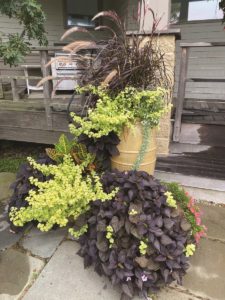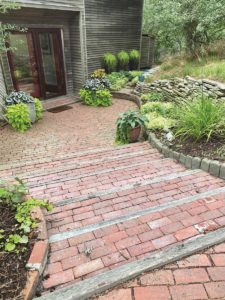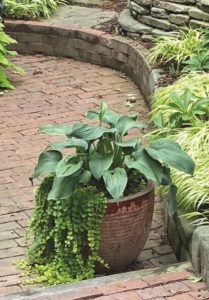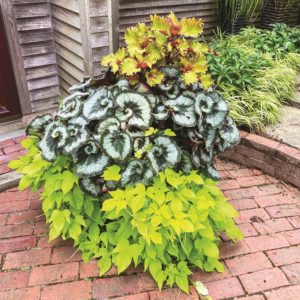One of the things we humans like to do is to bring little chunks of nature into our immediate surroundings. This is what gardens are, and houseplants, too. We enjoy these things that connect us to nature in our own spaces — they bring not just beauty but elements of something bigger than us into our lives.


One satisfying way to achieve this is with planters. Especially if you do more than treat them as mere gardening afterthoughts.
Planters can be powerful design elements in our gardens and on our decks, patios, and porches. They can pack a lot of punch for such a small and easy-to-care-for system. And they are a wonderful option if you have limited space or time to invest in gardening. Almost any yard, balcony, entryway, or parking spot can accommodate a planter.
The pot itself and the plants are both elements of your design — you’ll consider their size, textures, and colors. First, think of the planter as the picture frame to the beautiful painting you are about to make in it. What do you want your space to feel like? Short, squat pots are visually stable. Taller pots will lend elegance and a sense of uplift. Are there colors to pick up — blues from a view of the water, a bit of color from the house or the patio? You can complement these colors calmly or contrast them boldly.
You should choose plants first for the environment they’ll be living in. Is your planter going to be in a sunny spot or in the shade of an oak tree? Embrace your conditions and choose plants accordingly.
Now you get to have some fun. Go plant shopping. Blow your budget just this once. But before you go full kid-in-a-candy-shop, make one choice: What is the big idea of this planter? What is the defining design idea that will guide your choices? Is this a planter for hummingbirds? Will you be playing with contrasting foliage colors, sizes, and textures? Will it be a planter of rich complementary flower colors — warm oranges and cool blues? Our minds rejoice when they discover themes and cohesion in the things we see, and a clearly executed design really tickles this part of the brain.
As you select your plants, consider repeating patterns. To start, instead of packing 15 different individual plants into your planter, choose five plants, get three of each, and let them repeat their relationships to one another.


One powerful concept is to ring the outer edge with plants of alternating color and texture — this creates pattern and flow. Let the bright chartreuse of a sweet potato vine have a texture play with a cluster of alyssum and pop against the neutral charcoal color of the planter. The soft grays of angel wings or dusty miller will set off just about any other color.
When you put that vertical burst of grass at the center, break the upward visual line with some soft, chunky sedum leaves.
Have fun. Indulge. You are the painter here, and you get to decide what sort of statement you want to make and what emotion to evoke. Don’t be afraid to completely disregard all the above advice and just get weird with it.
Most plants prefer soil that drains well. Make sure your pots have unobstructed drain holes to keep the soil from going boggy. It helps to use a fluffy container mix that contains pearlite to provide air space and structure for roots. These pots can get heavy, and since most plants’ root zones will never reach the bottom of the pot, filling them entirely with soil is not necessary. Putting old plastic bottles in the bottom of the planter will take up space and decrease its weight while helping to provide drainage.
Fill your pots nearly to the top, roll up your sleeves, and dig your hands into the warm soil. Gloves are not recommended for this. Get that rich soil under your nails. Nestle plants into the earth and gently push the soil in around their roots. Sprinkle some granular fertilizer on the top, and give them a good, thorough soaking. Water them often and fertilize a few more times throughout the growing season. Watch them expand, develop, and burst with surprises as the season rolls on into longer days and warm nights.



